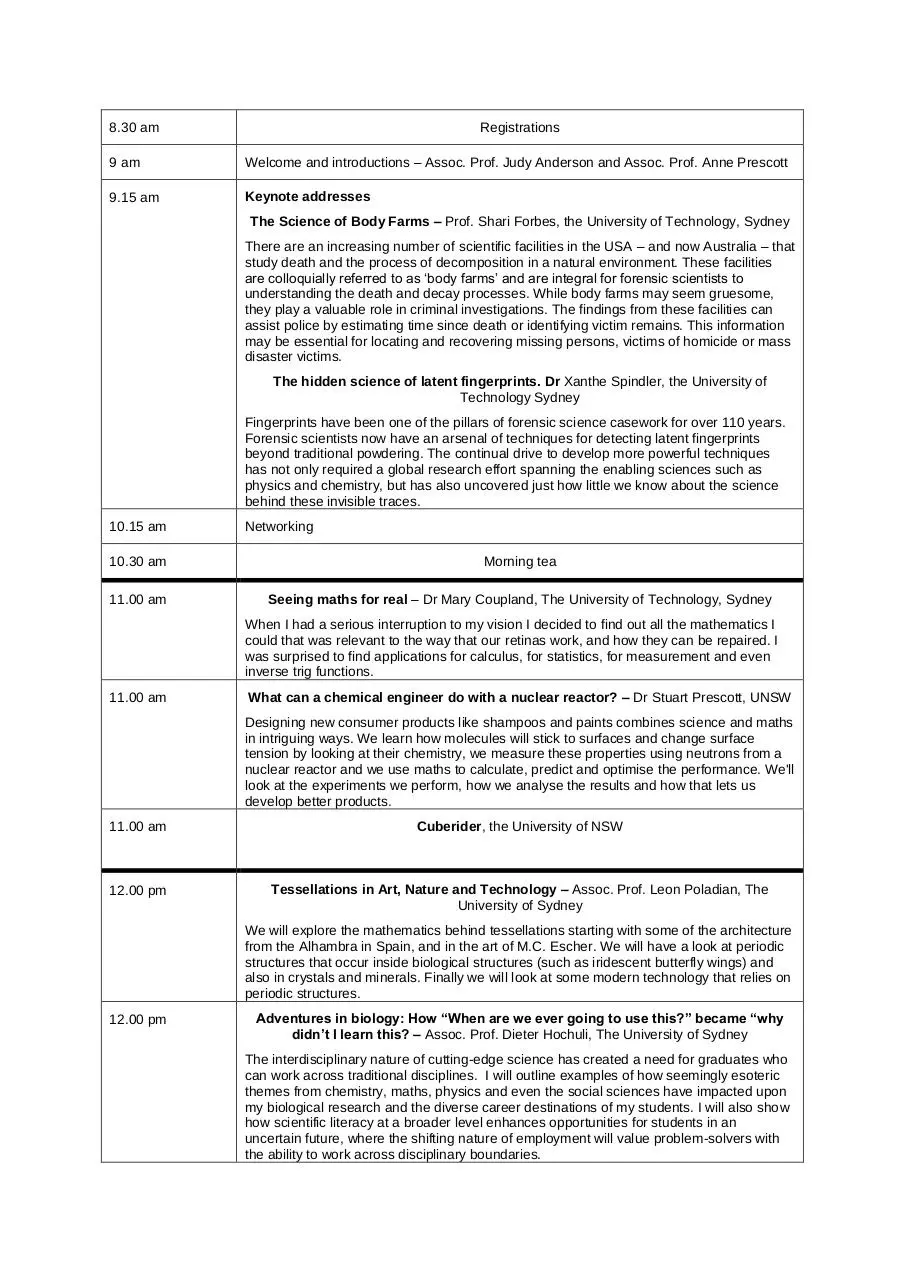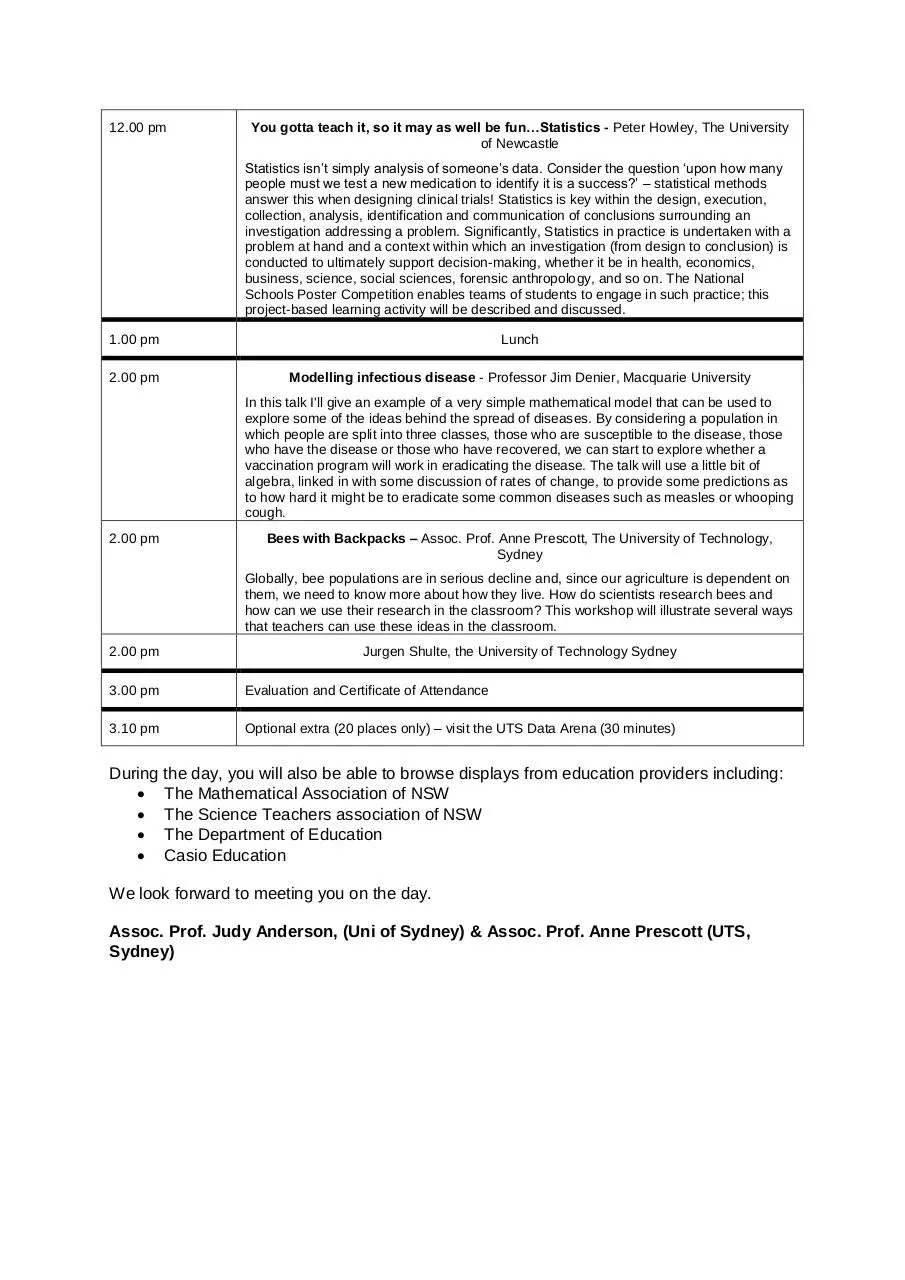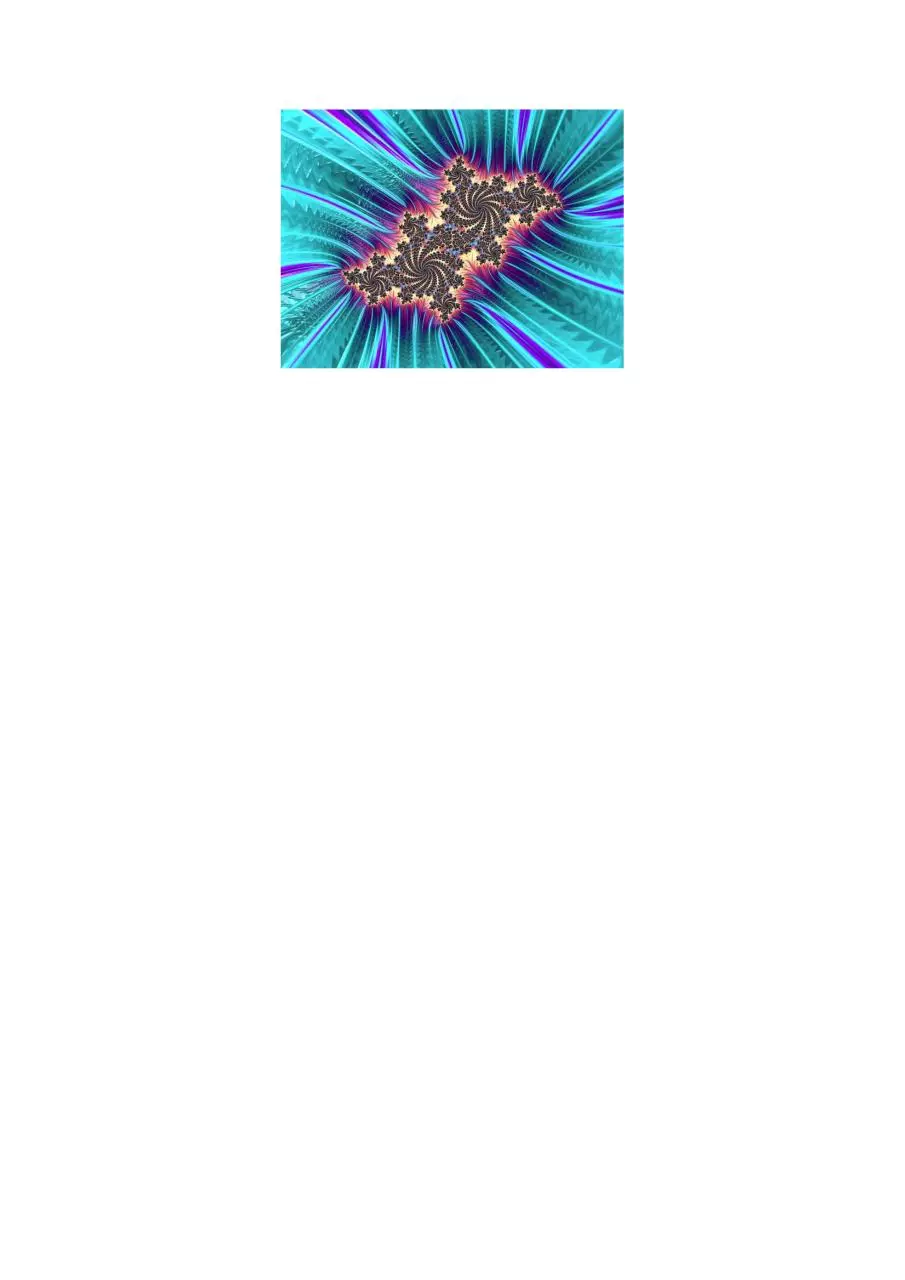STEM combined (PDF)
File information
Author: Anne Prescott
This PDF 1.6 document has been generated by Adobe Acrobat Pro 10.0.0, and has been sent on pdf-archive.com on 23/09/2016 at 23:44, from IP address 58.111.x.x.
The current document download page has been viewed 562 times.
File size: 752.83 KB (6 pages).
Privacy: public file





File preview
STEM into Action:
Preparing for the Classroom
Friday 30 September 2016
9am – 3pm
Aerial Function Centre, UTS
Building 10 Level 7
Jones St Ultimo
Final Program
This one day conference for Mathematics and Science pre-service teachers is
supported by a grant from the Office of the Chief Scientist through the IMSITE (Inspiring
Mathematics and Science Initial Teacher Education) project. It is designed to connect
Mathematics and Science pre-service teachers with Mathematicians and Scientists from
across the Sydney region.
The aim of the conference is to prepare pre-service teachers for their first appointment
in secondary schools by addressing the eternal question posed by secondary students:
When are we ever going to use this?
During the keynote and workshops, scientists and mathematicians will examine the many
ways their research links to the secondary school curriculum enabling pre-service teachers
to consider how they can make lessons more interesting and engaging for their students.
8.30 am
Registrations
9 am
Welcome and introductions – Assoc. Prof. Judy Anderson and Assoc. Prof. Anne Prescott
9.15 am
Keynote addresses
The Science of Body Farms – Prof. Shari Forbes, the University of Technology, Sydney
There are an increasing number of scientific facilities in the USA – and now Australia – that
study death and the process of decomposition in a natural environment. These facilities
are colloquially referred to as ‘body farms’ and are integral for forensic scientists to
understanding the death and decay processes. While body farms may seem gruesome,
they play a valuable role in criminal investigations. The findings from these facilities can
assist police by estimating time since death or identifying victim remains. This information
may be essential for locating and recovering missing persons, victims of homicide or mass
disaster victims.
The hidden science of latent fingerprints. Dr Xanthe Spindler, the University of
Technology Sydney
Fingerprints have been one of the pillars of forensic science casework for over 110 years.
Forensic scientists now have an arsenal of techniques for detecting latent fingerprints
beyond traditional powdering. The continual drive to develop more powerful techniques
has not only required a global research effort spanning the enabling sciences such as
physics and chemistry, but has also uncovered just how little we know about the science
behind these invisible traces.
10.15 am
Networking
10.30 am
Morning tea
11.00 am
Seeing maths for real – Dr Mary Coupland, The University of Technology, Sydney
When I had a serious interruption to my vision I decided to find out all the mathematics I
could that was relevant to the way that our retinas work, and how they can be repaired. I
was surprised to find applications for calculus, for statistics, for measurement and even
inverse trig functions.
11.00 am
What can a chemical engineer do with a nuclear reactor? – Dr Stuart Prescott, UNSW
Designing new consumer products like shampoos and paints combines science and maths
in intriguing ways. We learn how molecules will stick to surfaces and change surface
tension by looking at their chemistry, we measure these properties using neutrons from a
nuclear reactor and we use maths to calculate, predict and optimise the performance. We'll
look at the experiments we perform, how we analyse the results and how that lets us
develop better products.
11.00 am
Cuberider, the University of NSW
12.00 pm
Tessellations in Art, Nature and Technology – Assoc. Prof. Leon Poladian, The
University of Sydney
We will explore the mathematics behind tessellations starting with some of the architecture
from the Alhambra in Spain, and in the art of M.C. Escher. We will have a look at periodic
structures that occur inside biological structures (such as iridescent butterfly wings) and
also in crystals and minerals. Finally we will look at some modern technology that relies on
periodic structures.
12.00 pm
Adventures in biology: How “When are we ever going to use this?” became “why
didn’t I learn this? – Assoc. Prof. Dieter Hochuli, The University of Sydney
The interdisciplinary nature of cutting-edge science has created a need for graduates who
can work across traditional disciplines. I will outline examples of how seemingly esoteric
themes from chemistry, maths, physics and even the social sciences have impacted upon
my biological research and the diverse career destinations of my students. I will also show
how scientific literacy at a broader level enhances opportunities for students in an
uncertain future, where the shifting nature of employment will value problem-solvers with
the ability to work across disciplinary boundaries.
12.00 pm
You gotta teach it, so it may as well be fun…Statistics - Peter Howley, The University
of Newcastle
Statistics isn’t simply analysis of someone’s data. Consider the question ‘upon how many
people must we test a new medication to identify it is a success?’ – statistical methods
answer this when designing clinical trials! Statistics is key within the design, execution,
collection, analysis, identification and communication of conclusions surrounding an
investigation addressing a problem. Significantly, Statistics in practice is undertaken with a
problem at hand and a context within which an investigation (from design to conclusion) is
conducted to ultimately support decision-making, whether it be in health, economics,
business, science, social sciences, forensic anthropology, and so on. The National
Schools Poster Competition enables teams of students to engage in such practice; this
project-based learning activity will be described and discussed.
1.00 pm
Lunch
2.00 pm
Modelling infectious disease - Professor Jim Denier, Macquarie University
In this talk I'll give an example of a very simple mathematical model that can be used to
explore some of the ideas behind the spread of diseases. By considering a population in
which people are split into three classes, those who are susceptible to the disease, those
who have the disease or those who have recovered, we can start to explore whether a
vaccination program will work in eradicating the disease. The talk will use a little bit of
algebra, linked in with some discussion of rates of change, to provide some predictions as
to how hard it might be to eradicate some common diseases such as measles or whooping
cough.
2.00 pm
Bees with Backpacks – Assoc. Prof. Anne Prescott, The University of Technology,
Sydney
Globally, bee populations are in serious decline and, since our agriculture is dependent on
them, we need to know more about how they live. How do scientists research bees and
how can we use their research in the classroom? This workshop will illustrate several ways
that teachers can use these ideas in the classroom.
2.00 pm
Jurgen Shulte, the University of Technology Sydney
3.00 pm
Evaluation and Certificate of Attendance
3.10 pm
Optional extra (20 places only) – visit the UTS Data Arena (30 minutes)
During the day, you will also be able to browse displays from education providers including:
The Mathematical Association of NSW
The Science Teachers association of NSW
The Department of Education
Casio Education
We look forward to meeting you on the day.
Assoc. Prof. Judy Anderson, (Uni of Sydney) & Assoc. Prof. Anne Prescott (UTS,
Sydney)
STEM into Action:
Preparing for the Classroom
Friday 30 September 2016
9am – 3pm
Aerial Function Centre, UTS
Building 10 Level 7
Jones St Ultimo
This one day conference for Mathematics and Science pre-service teachers is
supported by a grant from the Office of the Chief Scientist through the IMSITE (Inspiring
Mathematics and Science Initial Teacher Education) project. It is designed to connect
Mathematics and Science pre-service teachers with Mathematicians and Scientists from
across the Sydney region.
The aim of the conference is to prepare pre-service teachers for their first appointment
in secondary schools by addressing the eternal question posed by secondary students:
When are we ever going to use this?
During the keynote and workshops, scientists and mathematicians will examine the many
ways their research links to the secondary school curriculum enabling pre-service teachers
to consider how they can make lessons more interesting and engaging for their students.
Pre-service mathematics and science teachers from the Sydney-based universities are
invited to attend but the numbers are strictly limited to 120 places. Register now and pay
$20 to secure your place. Upon arrival at the conference venue, you will receive a ‘teacher
starter kit’ valued at over $50. Morning tea and lunch will be provided at no extra cost.
The link to register for the STEM into Action: Preparing for the Classroom Pre–service
Teacher Conference on Friday 30 September 2016 is:
http://www.sydney.nicheit.com.au/education_social_work/register.php?wsid=ws0711
Your $20 payment must be made by Credit/Debit Card to confirm a place
Here is the plan for the day:
8.30 am
Registrations
9 am
Welcome and introductions
9.15 am
Keynote address
10.15 am
Networking
10.30 am
Morning tea
11.00 am
Workshop A1
Workshop A2
Workshop A3
12.00 pm
Workshop B1
Workshop B2
Workshop B3
1.00 pm
2.00 pm
Lunch
Workshop C1
Workshop C2
Workshop C3
3.00 pm
Evaluation and Certificate of Attendance
3.10 pm
Optional extra (20 places only) – visit the UTS Data Arena (30 minutes)
During the day, you will also be able to browse displays from education providers.
When the program has been finalized, it will be emailed to you.
We look forward to meeting you on the day.
Assoc. Prof. Judy Anderson, (Uni of Sydney) & Assoc. Prof. Anne Prescott (UTS,
Sydney)
Download STEM combined
STEM combined.pdf (PDF, 752.83 KB)
Download PDF
Share this file on social networks
Link to this page
Permanent link
Use the permanent link to the download page to share your document on Facebook, Twitter, LinkedIn, or directly with a contact by e-Mail, Messenger, Whatsapp, Line..
Short link
Use the short link to share your document on Twitter or by text message (SMS)
HTML Code
Copy the following HTML code to share your document on a Website or Blog
QR Code to this page

This file has been shared publicly by a user of PDF Archive.
Document ID: 0000486529.